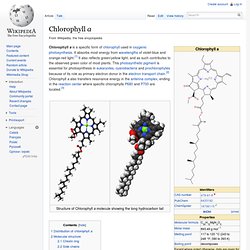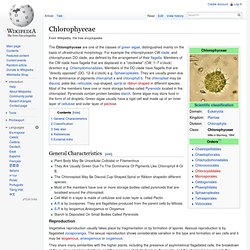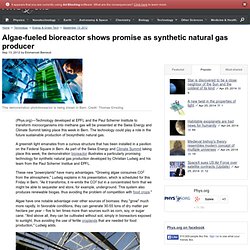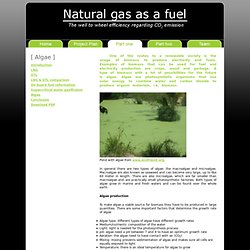

Glaucophyte. The glaucophytes, also known as glaucocystophytes or glaucocystids, are a small group of freshwater microscopic algae.[1] Together with the red algae (Rhodophyta) and green algae plus land plants (Viridiplantae or Chloroplastida), they form the Archaeplastida.

However, the relationships among the red algae, green algae and glaucophytes are unclear,[2] in large part due to limited study of the glaucophytes. The glaucophytes are of interest to biologists studying the development of chloroplasts because some studies suggest they may be similar to the original algal type that led to green plants and red algae.[1][3] Characteristics[edit] The chloroplasts of glaucophytes are known as 'cyanelles'. Glaucophytes have mitochondria with flat cristae, and undergo open mitosis without centrioles. Classification[edit] Only 13 species of glaucophytes are known, none of which is particularly common in nature.[1] The three included genera are: References[edit] External links[edit] Biodiesel from Algae Oil. Figure 1.

Algae-filled tubes in a bioreactor system that produces biodiesel fuel. ([1]) Introduction By Allison Vela-Mendoza Algae are eukaryotes and conduct photosynthesis within membrane-bound organelles called chloroplasts. Chloroplasts contain circular DNA that is similar in structure to cyanobacteria. Algae are prominent in bodies of water, common in terrestrial environments. Algal organisms are photosynthetic macro-algae or microalgae growing in aquatic environments. Microalgae are unicellular photosynthetic microorganisms, living in saline or fresh water environments that convert sunlight, water and carbon dioxide to algal biomass. Among the eukaryotic, green microalgae of the class Chlorophyceae, those most widely utilized belong to the genera Chlamydomonas, Chlorella, Haematococcus, and Dunaliella.
Cyanobacteria. By producing oxygen as a gas as a by-product of photosynthesis, cyanobacteria are thought to have converted the early reducing atmosphere into an oxidizing one, which dramatically changed the composition of life forms on Earth by stimulating biodiversity and leading to the near-extinction of oxygen-intolerant organisms.

According to endosymbiotic theory, the chloroplasts found in plants and eukaryotic algae evolved from cyanobacterial ancestors via endosymbiosis. Ecology[edit] A cyanobacteria bloom near Fiji Aquatic cyanobacteria are known for their extensive and highly visible blooms that can form in both freshwater and marine environments. Chlorophyll a. Chlorophyll a is a specific form of chlorophyll used in oxygenic photosynthesis.

It absorbs most energy from wavelengths of violet-blue and orange-red light.[1] It also reflects green/yellow light, and as such contributes to the observed green color of most plants. This photosynthetic pigment is essential for photosynthesis in eukaryotes, cyanobacteria and prochlorophytes because of its role as primary electron donor in the electron transport chain.[2] Chlorophyll a also transfers resonance energy in the antenna complex, ending in the reaction center where specific chlorophylls P680 and P700 are located.[3] Distribution of chlorophyll a[edit] This table shows the distribution of different photosynthetic pigments among many different organisms. Chlorophyll a (red) is produced by all oxygenic, photosynthetic organisms (modified from 2). Chlorophyll a is essential for most photosynthetic organisms to release chemical energy but is not the only pigment that can be used for photosynthesis.
Chlorophyceae. The Chlorophyceae are one of the classes of green algae, distinguished mainly on the basis of ultrastructural morphology.

For example the chlorophycean CW clade, and chlorophycean DO clade, are defined by the arrangement of their flagella. Members of the CW clade have flagella that are displaced in a "clockwise" (CW, 1–7 o'clock) direction e.g. Chlamydomonadales. Members of the DO clade have flagella that are "directly opposed" (DO, 12–6 o'clock) e.g. Biofuels and By-Products from Algae.
Learning - Biofuels Basics. This video provides an overview of NREL research on converting biomass to liquid fuels.

Text Version Unlike other renewable energy sources, biomass can be converted directly into liquid fuels, called "biofuels," to help meet transportation fuel needs. The two most common types of biofuels in use today are ethanol and biodiesel. Ethanol is an alcohol, the same as in beer and wine (although ethanol used as a fuel is modified to make it undrinkable).
It is most commonly made by fermenting any biomass high in carbohydrates through a process similar to beer brewing. Ethanol can also be produced by a process called gasification. Ethanol is mostly used as blending agent with gasoline to increase octane and cut down carbon monoxide and other smog-causing emissions. Biodiesel is made by combining alcohol (usually methanol) with vegetable oil, animal fat, or recycled cooking grease. Algae-fueled bioreactor shows promise as synthetic natural gas producer. (Phys.org)—Technology developed at EPFL and the Paul Scherrer Institute to transform microorganisms into methane gas will be presented at the Swiss Energy and Climate Summit taking place this week in Bern.

The technology could play a role in the future sustainable production of biosynthetic natural gas. A greenish light emanates from a curious structure that has been installed in a pavilion on the Federal Square in Bern. As part of the Swiss Energy and Climate Summit taking place this week, the demonstration bioreactor illustrates a particularly promising technology for synthetic natural gas production developed by Christian Ludwig and his team from the Paul Scherrer Institue and EPFL. These new "powerplants" have many advantages. "Growing algae consumes CO2 from the atmosphere," Ludwig explains in his presentation, which is scheduled for this Friday in Bern. How Much Does Biodiesel Cost. To answer the question "How much does biodiesel cost" we need to look at direct costs such as raw materials as well as indirect costs like labor.

The first direct cost is the oil. Usually home biodiesel producers use old cooking oil. If you have to pay for the oil (which is common in certain countries) then you need to make sure that once you add the cost of the chemicals it is still cost effective. The second portion of the direct cost is the process chemicals. This is usually less than US$ 0.10 per liter. You can do a basic costing yourself by filling in the following table. Custom Search. MDP Project: Natural Gas as a fuel. One of the routes to a renewable society is the usage of biomass to produce electricity and fuels.

Examples of biomass that can be used for fuel and electricity production are crops, wood and garbage. A type of biomass with a lot of possibilities for the future is algae. Algae are photosynthetic organisms that use solar energy to combine water and carbon dioxide to produce organic materials, i.e. biomass.